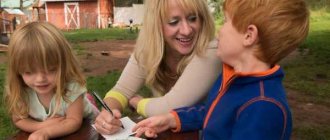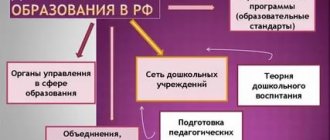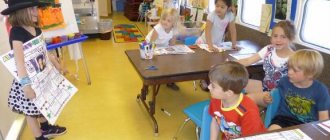Today there are a huge number of different development methods and systems, including non-standard ones, for preschool development and upbringing of a child. Every year - more and more. It is not surprising that this causes a mixed reaction among professionals: there is a Federal State Educational Standard, there are programs, what other “lettergrams” and “spiritual approach to the development of a child’s free personality”? There is definitely a subject for debate. Our expert Marina Bolotova, the scientific director of preschool educational organizations, has carefully studied many popular and original modern methods due to her work. This article is a specialist’s answers to the TOP 5 alternatives to the classical approach. So as not to miss the important things behind the emotions.
All the methods we talk about in this article are focused on the environmental approach: the child is in a specially organized environment that best satisfies the child’s needs.
Montessori pedagogy
Technology invented by teacher Maria Montessori. Initially, she conceived the approach to work with “special” children, but then transferred it to everyone else. The main idea of the approach is that every child has a powerful potential for development; you just need to create conditions using a special environment and not disturb the child.
What principles does it work on?
- A special environment is created, divided into five zones. Practical for the development of everyday skills, sensory with toys of different shapes, sizes, colors, mathematical for the development of counting skills and familiarity with geometric shapes and symbols, language zone for learning letters and syllables, space zone for getting to know the outside world and the mysteries of nature.
- Classes are held in different age groups. Older children interact with younger ones: they pass on their skills to the younger ones and not only teach them, but also develop their skills even better.
- Teachers do not impose or forbid anything on the child - he makes the choice to play with dolls, draw or jump and run. The teacher only presents the material and reveals it as much as possible.
What goals does the child achieve?
- Learns independence. Free choice of activities also develops self-confidence and self-confidence.
- Learns to respect others. Children work and play quietly to respect the time and space of others. You can let off steam in a special “motor” zone. Children also clean up toys after themselves and follow the principle “whoever takes it first gets to play.”
- He studies mathematics, learns about nature and culture. This is helped by working in different zones.
- The teacher must respect children and their choice: give them the opportunity to play and choose the pace of classes.
- The teacher must be able to create an environment. Many toys are made by hand from natural materials.
- The teacher must be able to captivate children. It is he who presents materials for games and activities, and he serves as a model in group creative activities.
Modern educational technologies in preschool educational institutions
Modern educational technologies in preschool educational institutions
Preschool education in the 21st century is rapidly changing; the introduction of new technologies into the educational process of preschool institutions contributes to the more effective education of a child who strives to creatively approach solving various life situations and wants to gain new knowledge about the world around him. In modern life, a child receives a lot of varied information from everywhere! The task of teachers is to help the child learn to find and extract the necessary information, to assimilate it in the form of new knowledge. The use of innovative pedagogical technologies opens up new opportunities for the education and training of preschool children. The use of modern educational technologies influences the formation of positive motivation for further learning. Technology is a set of various techniques that are used in a particular business, craft or art; the use of modern pedagogical technologies increases the level of educational activities.
The main thing is not just to transfer any knowledge, but to develop cognitive interest in children and the desire to acquire knowledge, thereby ensuring continuity of preschool and primary school education.
Bookcrossing technology What is bookcrossing? The essence of this concept is simple - it is a “book turn” (“movement of books” from person to person).
Our book library, which is located in the kindergarten hall, is available to all participants in the educational process.
Parent, child or teacher - anyone can take a book they like and leave one of their own in return, the main thing is that the number of books in the library does not decrease.
The purpose of bookcrossing in kindergarten is to increase interest in reading and literature.
The implementation of this technology began with the design of the “Literary Corner”, in which various exhibitions and vernissages are systematically organized.
Participation in the project “Saving the Planet Together” helps to develop an environmental culture in children, a careful attitude towards the environment, and the importance of recycling secondary raw materials for nature conservation.
Parents showed interest in projects, new methods and psychological and pedagogical approaches, supported high-quality modern children's literature, as well as the idea of freedom and independence of the child in organizing the educational process.
Talking Walls Technology
One of the classics of Russian pedagogy claimed that he “educates everything: people, books, and concepts.” It turns out that even “walls” can educate in kindergarten. The main idea of the “talking wall” is to transform a child’s usual environment into a learning and “educating” one.
The “talking wall” is a kind of living screen. Various thematic pictures are attached to the walls in the group and kindergarten premises. I actively use “Talking Walls” in my work: on physical education “I’m growing”, on social and communicative development: “My emotions”, “Our birthday people”, “Tree of polite words”. Also, on the “talking walls” in the kindergarten premises, material is placed in accordance with the seasons, according to thematic weeks that take place in the kindergarten, it is aimed at the artistic and aesthetic education of preschoolers. Therefore, the purpose of organizing “talking walls” in the group was to assimilate, consolidate, expand knowledge, as well as develop communication skills.
The purpose of the “talking wall” in the group is to conduct a “Morning of Good Meetings”, which establishes emotional contact between the participants in the conversation, establishes an atmosphere of trust, sets the tone for favorable communication during the day, develops the ability to exchange knowledge and experience, and motivates to gain new knowledge.
The “Morning of Good Meetings” technology is organized to make children feel like part of a close-knit team; participation in the event helps them realize that they belong to the team, teaches respect for peers and elders, and also develops the ability of collective interaction. Children discuss what they have learned during the week, discuss a plan of action for the current day, and agree on who will be responsible for what.
Technology "Kindergarten without offense." Creating conditions for conflict-free communication, developing the ability to behave in a conflict situation, cultivating a sensitive, attentive attitude towards each other - this is the goal that the group strived for when organizing the “Polite Words” box. The children wrote and drew good and kind words and wishes for her.
Technology "Social shares". One of the tasks of the educational field “Socio-communicative development” is the moral education of preschool children. Participation in social events together with parents helps to form the foundation of spiritual and moral education in children; an understanding of the concepts is laid: love for the Motherland, kindness, care, compassion, family values, respect for elders.
Based on the fact that social action is the basis for the formation of children’s attitude towards social life, parents and students of our kindergarten take an active part in events of social significance.
The main goal of these events is to form children’s attitude towards public life and develop their civic position.
In the kindergarten, teachers and parents organized many events that helped bring this technology to life:
collection of batteries and waste paper,
holding a competition “Bird Feeder”,
release of wall newspapers for significant dates: February 23, March 8, MAY 9.
organization of the labor force “Let’s Help the Janitor”, participation of teachers, parents and children in community cleanups.
The “Dove in the Window” campaign, preserving the memory of the Great Patriotic War and veterans.
By implementing technologies in the direction of “Socio-communicative development,” my parents and I were convinced that children became more open, they gained confidence in their own abilities, and they learned to negotiate with each other.
The technology of project activity (project method) is purposeful activity according to a specific plan to solve search, research, and practical problems in any area of educational content. The purpose of this technology is to develop the free creative personality of the child. The core of the technology of project activity is the independent activity of children - research, cognitive, productive, in the process of which the child learns about the world around him and embodies new knowledge into real products. In this case, a project is any activity performed with a high degree of independence by a group of children united at the moment by a common interest. The use of this technology not only prepares the child for life in the future, but also helps organize life in the present. This method is based on individual interests and increases the independent activity of kindergarten students. The knowledge acquired during the preparation of the project becomes part of their personal experience.
The following projects were implemented: “Young Travellers”, “Little Books”, “My Future Profession”, “We Remember and Are Proud”.
Game-based learning technology. Play, the most important activity, plays a huge role in the development and upbringing of a child.
“Play has the same importance in a child’s life as activity – work, service – in an adult. What a child is like at play, so in many ways he will be at work when he grows up. Therefore, the education of a future figure occurs, first of all, in the game...” A.S. Makarenko
In the light of the Federal State Educational Standard for Preschool Education, the child’s personality is brought to the fore, and now the entire preschool childhood should be devoted to play. The use of gaming technologies contributes to the development of a preschooler’s individuality. This is a kind of foundation for the entire educational process.
The value of gaming technology is not that it is entertainment and relaxation, but that with the right guidance it becomes:
way of teaching;
activities for the realization of creativity;
the first step in the socialization of a child in society.
For example, the game “Wonderful Bag”. Goal: ideas about the properties and qualities of objects are clarified, specified and enriched, children master sensory standards.
"Seasons". Goal: to systematize children’s knowledge about the phenomena of inanimate nature.
“Find a tree by a leaf”, “Test by taste”, “Find the same leaf”. Goal: to help distinguish objects by qualities and properties, to develop observation skills.
Gaming technology involves modeling situations, creating a plot and characters, as well as finding the necessary actions to complete a task in accordance with established rules. At the same time, pedagogical games are organized on the initiative and under the control of the teacher. They select and prepare the material, involve the children, control the course of the game itself, and sum up the results.
The use of game material in the education of preschool children has a number of advantages: it increases the efficiency of knowledge acquisition; develops memory, attention, creative thinking; teaches to distinguish and generalize objects based on characteristic features; separate fiction from reality; develops reaction speed and ingenuity.
The scope of application of gaming technologies in the work of preschool educational institutions is almost limitless, since play is the main type of child activity. By acting in a playful situation, children more effectively learn material of any complexity.
The purpose of gaming technology is not to change or remake the child, not to teach him any special behavioral skills, but to give him the opportunity to “live” situations that excite him in the game with the full attention and empathy of an adult.
Problem-based learning technology is an organization of activities that involves the creation of problem situations under the guidance of a teacher and the active independent activity of children to resolve them.
The solution to the problem problem is carried out under the guidance of the teacher according to the following algorithm:
* Awareness of the contradiction inherent in the task.
*Formation of a hypothesis for its resolution.
*Joint search for confirmation of the hypothesis.
*Formulation of a conclusion that clarifies cause-and-effect relationships and expands knowledge about the subject. (For example: - Why do birds have beaks of different shapes? - What tree did we decorate for the New Year? - Can a needle be called a leaf. Let’s draw up rules of behavior on the bus for passengers who cannot read.) etc.
The described algorithm assumes a sufficient level of development of analytical thinking, which is why it is advisable to use problematic technologies in groups of older preschool age.
Information and communication technologies
Information and communication technologies (ICT) of preschool education are a set of educational and methodological materials based on the use of technical means and software in raising children and aimed at improving the pedagogical activities of preschool workers. ICTs involve the use of educational videos, audio recordings, multimedia presentations, electronic manuals, etc. in the pedagogical process.
Working on the introduction of new technologies, I relied on the joint work of children and their parents, during which the children were able to develop their cognitive abilities and creative thinking, learned to find information without the help of others, and also apply acquired knowledge. As part of the implementation of these technologies in the preschool educational institution, each child strived to to vigorous activity, and adults were convinced that positive creative results can be expected from children.
Based on the results of monitoring educational activities, an increase in indicators was revealed in all educational areas. That is, it can be assumed that these technologies qualitatively influence the results of educational activities in preschool educational institutions. The main task in working with preschoolers was realized - the activation and development of the child’s creative and cognitive activity, independence in choosing methods of action in various situations.
To summarize, we can say with confidence that modern educational technologies are being used more and more often in preschool educational institutions, and the results of their implementation will be evident for many decades to come. After all, school and adult life lie ahead. Kindergarten is the first step in a child’s general systematic education, his first experience of participation in public life. One of the main tasks according to the Federal State Educational Standard for Education is to reveal the abilities of each child, to educate an individual with creative thinking, ready for life in a high-tech information society, and with the ability to learn throughout life.
Bibliography:
1. Veraksa N. E., Veraksa A. N. Project activities of preschoolers. A manual for teachers of preschool institutions. – M. Mosaika-Sintez, 2010. – 112 p.
2. V.V. Gerbova “Development of speech” - MOSAIC SYNTHESIS.
3. Davydov V.V. “Theory of developmental training. – M., 1996.
4. https://www.knigadeti.ru /Book of the year: chosen by children.
5. Kokueva L.V. Spiritual and moral education of preschool children based on the cultural traditions of their people. Toolkit. – M.: ARKTI, 2005.- 144 p. (Development and education).
6. Morozova L. D. Pedagogical design in preschool educational institutions; from theory to practice. Supplement to the journal "Preschool Education Management" Sphere. 2010
7. Nikolaeva S. N. Concept of environmental education of preschool children. – M.: International Academy of Ecology and Life Safety Sciences, 1996.
8. Nikolaeva S. N. Methods of environmental education in kindergarten. – M.: Education, 1999.
9. "From birth to school." Approximate general educational program for preschool education / Ed. N. E. Veraksy, T. S. Komarova, M. A. Vasilyeva. - M.: MOSAIC SYNTHESIS, 2014.
10. Poddyakov A.I. Combinatorial experimentation of preschoolers with a multiconnected object - a “black box” // Questions of Psychology, 1990. - No. 5.-S. 65-71.
11. Poddyakov A.I. Preschool child: problems of mental development and self-development // Preschool education, 1998.-No. 12. -WITH. 68-74.
12. Federal state educational standard for preschool education (Approved by order of the Ministry of Education and Science of the Russian Federation dated October 17, 2013 No. 1155. Registered by order of the Ministry of Justice of the Russian Federation No. 30384 dated November 14, 2013).
13. Khabarova T.V. Pedagogical technologies in preschool education. Saint Petersburg. Childhood-Press. 2011
Reggio pedagogy
Italian technology, based on the ideas of Vygotsky and Maria Montessori. The author of the technology is Loris Malaguzzi. Malaguzzi believed that the child had at least 100 languages, but 99 of them were stolen. Much in a child’s life happens at the direction of adults, even holidays. The main postulate is that the environment must meet the needs and capabilities of the child.
What principles does it work on?
- A separate program includes space for the child. He can even retire and do only what he wants.
- The parent is completely immersed in the work of the kindergarten. He sometimes goes to kindergarten with the child, helps, and becomes a partner.
- There is no assessment and control - no final tests. The Reggio teacher uses observation, records the results of the child’s work, but does not give an assessment.
What goals does the child achieve?
- Learns partnership. Children are taught to work in groups so that they learn to negotiate, cooperate, and get used to the fact that they are “not alone.”
- Studies culture. Classes are not limited to the kindergarten environment: children are taken on excursions, helped to understand relationships between people, the rules of society, and traditions.
- Learns free choice. The child himself chooses the pace of classes and the materials with which he will play.
What should a teacher be like?
The teacher must follow six rules:
- Respect the child and look him in the eye.
- Explain the rules and ask a question. Only this way, and not the other way around.
- Not “wrong”, but “different”.
- Offer choice and don't rush.
- Learn in any situation.
- Fantasizing is more important than reading.
Combination of programs and technologies
In the education of preschool children, the greatest results are shown by the comprehensive use and integration in different versions of all modern technologies and programs. Experienced teachers and educators know this feature, so they try to combine them as much as possible in their teaching activities.
Different approaches are combined in one type of task, which allows not only to quickly gain knowledge and consolidate skills, but also to keep the student’s attention for the required time, which usually creates a problem in classes with preschoolers.
This direction is considered the most promising in the whole world, since it has repeatedly confirmed its effectiveness through practical experiments. In addition, with this approach, the risk of individual students with individual requirements “dropping out” from the general educational process is minimized.
Voskobovich games
Educational games created by physicist-engineer Vyacheslav Voskobovich. They represent a developing environment of different zones and elements, united by one fairy-tale plot.
What principles does it work on?
- It is based on three principles: interest, knowledge and creativity. This builds cognitive and research skills.
- Games are developed in accordance with the interests of the children. Each can be used by children from 2 to 7 years old; for younger children the tasks are simpler.
- The developmental environment “Purple Forest” has been developed for games, with several zones in which the child fulfills certain needs.
What goals does the child achieve?
The main goals of technology are learning new things, developing the ability to observe, building confidence, a harmonious approach to the development of emotionality, imaginative thinking and logic.
What should a teacher be like?
- The teacher must understand the material: know the games, be able to build a plot.
- The teacher must involve the children in the game; some time must be spent getting to know its rules.
- The teacher does not evaluate the completion of assignments. Each age has its own level; if you can’t cope, you can move on to an easier one.
Dewey technology
John Dewey developed a practice-oriented approach. Dewey believed that a preschooler should engage in play and work activities, which gives him the necessary life experience.
What principles does it work on?
- Everything that happens to a child must be practically oriented. There is no need to overload the brain with unnecessary knowledge; you need to teach how to work with your own hands, and apply acquired knowledge and skills in other situations.
- Education should be aimed at gaining experience, which can only be accumulated by the child himself. Thinking is only a tool for solving problems. The child explores the world around him and ultimately wants to learn the necessary skills and experience them.
- In addition to work skills, geography and history are important. Geography helps to learn about the world around us, history helps us learn about the world and culture of people.
What goals does the child achieve?
- Gains life experience. The child learns to solve problems and develops skills.
- He understands geography and history. This helps to understand the world around us and people with their relationships.
- Learns to be entrepreneurial. This is facilitated by the projects that the teacher launches with the children.
What should a teacher be like?
- Must have strong instrumental skills, such as working with hands. Without this, he will not teach the necessary skills to children.
- Does not compare children with a friend - competition is prohibited in technology. The child is compared only with himself.
- Teaches children project activities. Projects help children gain experience and learn skills, as well as collaborate with others and develop their own entrepreneurial spirit.
Variability of preschool education programs
The modern education system is represented by six types of preschool educational institutions, therefore, educational programs aimed at preschool educational institutions are presented in various options. At the same time, the Federal State Educational Standards for Educational Institutions have been established, regulating the implementation of educational programs of preschool educational institutions and putting forward requirements for their development.
All preschool education programs are divided into two types:
- Comprehensive programs are general developmental programs focused on the implementation of education in all main areas of child development: physical, social, speech, moral, cognitive, artistic and aesthetic, communicative, personal. These programs include activities to reveal the child’s basic abilities, activate his creative potential, cognitive abilities and develop special types of children’s activities characteristic of a specific age group: subject, play, art, theater, music, design.
- Partial programs are specialized programs focused on the development of preschool children in a specific area. These could be health conservation programs, remedial education programs, environmental and patriotic development programs, programs for mastering non-standard activities (early reading, handicrafts, cooking, etc.).



